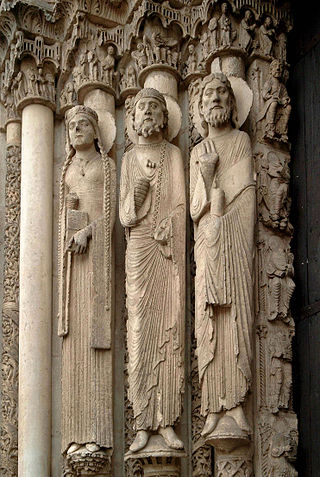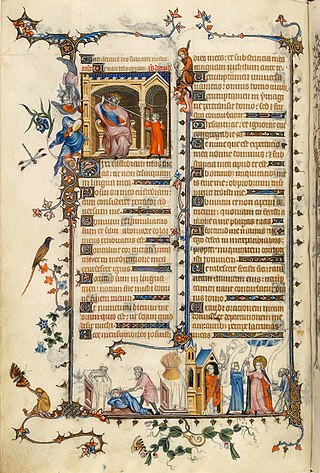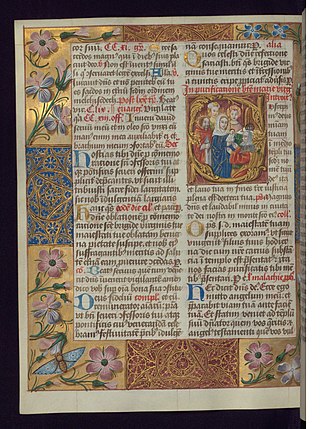Related Research Articles

Gothic art was a style of medieval art that developed in Northern France out of Romanesque art in the 12th century AD, led by the concurrent development of Gothic architecture. It spread to all of Western Europe, and much of Northern, Southern and Central Europe, never quite effacing more classical styles in Italy. In the late 14th century, the sophisticated court style of International Gothic developed, which continued to evolve until the late 15th century. In many areas, especially Germany, Late Gothic art continued well into the 16th century, before being subsumed into Renaissance art. Primary media in the Gothic period included sculpture, panel painting, stained glass, fresco and illuminated manuscripts. The easily recognizable shifts in architecture from Romanesque to Gothic, and Gothic to Renaissance styles, are typically used to define the periods in art in all media, although in many ways figurative art developed at a different pace.

Yvain, the Knight of the Lion is an Arthurian romance by French poet Chrétien de Troyes. It was written c. 1180 simultaneously with Lancelot, the Knight of the Cart, and includes several references to the narrative of that poem. It is a story of knight-errantry, in which the protagonist Yvain is first rejected by his lady for breaking a very important promise, and subsequently performs a number of heroic deeds in order to regain her favour. The poem has been adapted into several other medieval works, including Iwein and Owain, or the Lady of the Fountain.

Jean Pucelle was a Parisian Gothic-era manuscript illuminator who excelled in the invention of drolleries as well as traditional iconography. He is considered one of the best miniaturists of the early 14th century. He worked primarily under the patronage of the royal court and is believed to have been responsible for the introduction of the arte nuovo of Giotto and Duccio to Northern Gothic art. His work shows a distinct influence of the Italian trecento art Duccio is credited with creating. His style is characterized by delicate figures rendered in grisaille, accented with touches of color.
Jeffrey F. Hamburger is an American art historian specializing in medieval religious art and illuminated manuscripts. In 2000 he joined the faculty of Harvard University, where in 2008 he was appointed the Kuno Francke Professor of German Art and Culture. Hamburger received his B.A., M.A and Ph.D from Yale and has previously held professorships at Oberlin College and the University of Toronto. Elected a Fellow of the Medieval Academy in 2001, he has won numerous awards for his publications, among them: the Charles Rufus Morey Prize of the College Art Association (1999), the Roland H. Bainton Book Prize in Art & Music (1999), the Otto Gründler Prize of the International Congress on Medieval Studies (1999), the Jacques Barzun Prize in Cultural History of the American Philosophical Society (1998), the John Nicholas Brown Prize of the Medieval Academy of America (1994), and the Gustave O. Arlt Award in the Humanities of the American Council of Graduate Schools (1991). His research has been supported by fellowships from the Guggenheim Foundation, the American Philosophical Society, the Institute for Advanced Study, the National Endowment for the Humanities, the Center for Advanced Study in the Visual Arts, and the Alexander von Humboldt Foundation. In 2009 Hamburger was elected a member of the American Academy of Arts and Sciences and in 2010, of the American Philosophical Society. In 2015 he was awarded an Anneliese Maier Research Award by the Alexander von Humboldt Foundation. In 2022 he was awarded the Gutenberg Prize of the City of Mainz and the Internationale Gutenberg-Gesellschaft.

The object called by the museum Casket with Scenes of Romances is a French Gothic ivory casket made in Paris between 1330 and 1350, and now in the Walters Art Museum, Baltimore, Maryland. The casket is 4 5/8 inches high, 9 15/16 inches wide and 5 1/16 inches deep.
Lindy M. Grant,, is professor emerita of medieval history at the University of Reading, an honorary research fellow of the Courtauld Institute of Art, and a former president of the British Archaeological Association. Grant is a specialist in Capetian France and its neighbours in the 11th to 13th centuries.
Raluca L. Radulescu FLSW is professor of medieval literature at Bangor University. She is a specialist in Arthurian and non-Arthurian romances including Sir Thomas Malory and pious romances, medieval chronicles, political culture and gentry studies.

The Masters of the Dark Eyes Missal is a late 15th c. illuminated missal that was created in Utrecht, the Netherlands. The name of the Dutch missal is taken from an academic term that was used to describe a specific artistic movement, Masters of the Dark Eyes, that emerged from the Ghent-Bruges School and was named for its unique use of darkened areas around the eyes of its painted figures. The manuscript contains a total of 236 leaves that are made of parchment. The contents of the manuscript appears to have undergone rebinding during the 19th century and are now covered in a dark blue Morocco with gilded decorations. This illuminated medieval manuscript is currently in the Walters Art Museum in Baltimore, Maryland. The contents of the manuscript include illuminated miniatures and Flemish-style borders that feature flowers, insects, and jewels. Most of the written pages have two columns with 33 lines in red ink and Gothic Bastarda calligraphy.
Kathleen L. Scott is a codicologist specialising in 15th-century English manuscripts. An independent scholar, she is associated with the University of Massachusetts.
(Bernard) Paul Crossley, was professor of the history of art at the Courtauld Institute of Art, University of London. He was elected a fellow of the British Academy in 2016. He was a specialist in the architecture of medieval central Europe.
Kathryn Margaret Rudy FBA FRSE is a manuscript historian at the University of St Andrews, Scotland. She is best known for her forensic approach to medieval books, and has pioneered the use of the densitometer to measure the grime that original readers deposited in their books. Her research focuses on the medieval reception of manuscripts, how they were manipulated and handled, and how book-making skills were lost with the advent of the printing industry.
Zsuzsanna Gulácsi is a Hungarian-born American historian, art historian of pan-Asiatic religions. She is a professor of art history, Asian studies, and comparative religious studies at Northern Arizona University (NAU). Her teaching covers Early and Eastern Christian art, Islamic art, with special attention to the medium of the illuminated book; as well as late ancient and mediaeval Buddhist art from South, Central, and East Asia.
Carolyn Marino Malone is an American medievalist and academic. She is professor of art history and history at USC Dornsife College, Los Angeles, California, with a PhD in Art History and Medieval Studies (1973) from the University of California, Berkeley. Her research interests are English and French Romanesque and Gothic architecture and sculpture. She has published books on sculptural finds at Canterbury Cathedral, the abbey of St Bénigne in Dijon, the façade of Wells Cathedral, and monastic life in the Middle Ages. She served as Vice-President (1996-1997) and President (1999) of Art Historians of Southern California; Domestic Advisor to the Board of Directors of the International Center of Medieval Art (1984-1987); and was on the board of directors of the Medieval Association of the Pacific (1986-1989). She is a member of the Society of Architectural Historians.
Nicola Coldstream, FSA, is a British architectural historian and academic with special interests in the 13th and 14th centuries. Coldstream studied History and Fine Arts at Cambridge University and obtained her PhD at the Courtauld Institute of Art.
La Mule sans frein or La Demoiselle à la mule is a short romance dating from the late 12th century or early 13th century. It comprises 1,136 lines in octosyllabic couplets, written in Old French. Its author names himself as Païen de Maisières, but critics disagree as to whether this was his real name or a pseudonym. La Mule is an Arthurian romance relating the adventures, first of Sir Kay, then of Sir Gawain, in attempting to restore to its rightful owner a stolen bridle. It is notable for its early use of the "beheading game" theme, which later reappeared in the Middle English romance Sir Gawain and the Green Knight. It is sometimes seen as a skit or burlesque on earlier romances, especially those of Chrétien de Troyes, but it has also been suggested that it might have been written by Chrétien himself.
George David Smith Henderson is a British art historian, author, and Emeritus Professor of Medieval Art at the University of Cambridge. He is a Fellow of The Society of Antiquaries of London and a member of the Association of Art Historians. He was awarded the Reginald Taylor Prize by the British Archaeological Association in 1962 for his paper "The Sources of the Genesis Cycle at St.-Savin-sur-Gartempe".
Elżbieta Temple, properly Elżbieta Klewin née Malcz, was a scholar and writer specialising in the field of illuminated manuscripts who produced two books, the second co-authored with J. J. G. Alexander.
Achim Timmermann is a professor, specialising in Medieval and early modern art and architecture. He is Director of Medieval and Early Modern Studies at the University of Michigan, Ann Arbor.
Peter Draper, is an architectural historian who has, over his long academic career, specialised in medieval architecture with a particular interest in English ecclesiastical building, primarily cathedrals, and the relationship between the architecture and its social, political and liturgical functions. Latterly his research has extended to Islamic architecture and its influence on Western traditions. He is Professor emeritus and an honorary life member of Birkbeck College, University of London where he is currently Visiting Professor in the History of Architecture. He has published numerous articles and books including The Formation of English Gothic : Architecture and Identity, for which he won two prestigious awards; the Spiro Kostof Book Award from the Society of Architectural Historians in 2008 and the Alice Davis Hitchcock Medallion in 2009, awarded by the Society of Architectural Historians of Great Britain.
Rachel Moss is an Irish art historian and professor specialising in medieval art, with a particular interest in Insular art, medieval Irish Gospel books and monastic history. She is the current head of the Department of the History of Art at Trinity College Dublin, where she became a fellow in 2022.
References
- ↑ "The Way of Saint James".
- 1 2 "Professor Margaret Stones". Society of Antiquaries of London. Retrieved 17 July 2020.
- ↑ Stones, Alison (1970). The illustration of the French prose "Lancelot" in Flanders, Belgium and Paris, 1250-1340 (Thesis). OCLC 270910679.
- ↑ "M. Alison Stones, Ph.D., F.S.A., Chevalier de l'Ordre des Arts et des Lettres". History of Art and Architecture. Pittsburgh, Pennsylvania: University of Pittsburgh. 2011. Archived from the original on 30 January 2020. Retrieved 7 September 2020.
- 1 2 3 "France Honors June Hargrove, Jill Schoolman and Alison Stones". frenchculture.org. Retrieved 17 July 2020.
- 1 2 3 Wilson, Linda S. (7 September 1983). "In Just Three Trips, Pittsburgh Won His Heart". The Post Gazette . Pittsburgh, Pennsylvania. p. 4. Retrieved 7 September 2020– via Newspapers.com.
- ↑ "The Way of Saint James".
- ↑ "ACLS American Council of Learned Societies | www.acls.org - Results". www.acls.org. Retrieved 17 July 2020.
- ↑ "LA SNAF". snaf (in French). Retrieved 14 August 2020.
- ↑ "Artforum.com". www.artforum.com. 11 November 2015. Retrieved 16 July 2020.
- ↑ "National Education Leader Roger Benjamin to Speak at Barton's 108th Commencement". BC News. Wilson, North Carolina: Barton College. 16 April 2010. Archived from the original on 8 September 2015. Retrieved 7 September 2020.
- ↑ Sand, Alexa (1 January 2015). "15.01.26, Stones, Gothic Manuscripts: 1260-1320, Part 1". The Medieval Review. ISSN 1096-746X.
- ↑ "Who made the Conway Library?". Digital Media. 30 June 2020. Retrieved 14 August 2020.